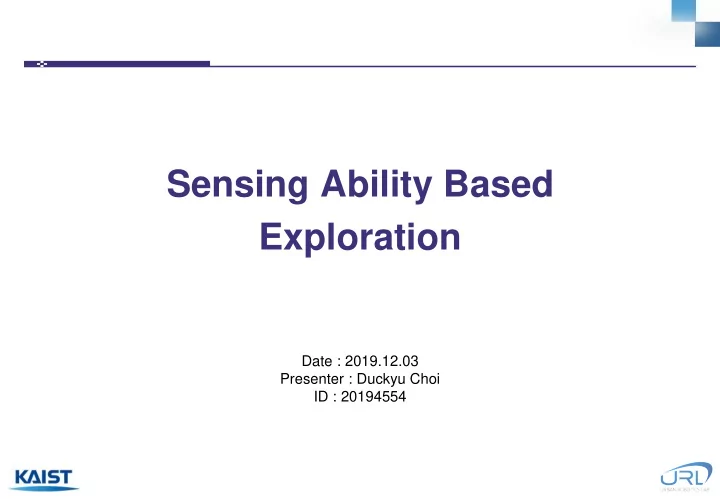

Sensing Ability Based Exploration Date : 2019.12.03 Presenter : Duckyu Choi ID : 20194554
0. Background Representing Space As for most sensors the perception stops at surfaces, hollow spaces or narrow pockets can sometimes not be explored with a given setup. This residual space denoted by Purpose of Exploration 1
0. Background Exploration Map is used for both, collision free navigation and determination of the exploration progress Localization Mapping Exploration Motion Control 2
0. Background Previous Exploration Method Frontier Based Exploration is one of them To gain the most new information about the world, move to the boundary between known space and unknown space Goal Observed area Frontier Robot C Unknown area 3
0. Background Previous Exploration Method Frontier Based Exploration is one of them To gain the most new information about the world, move to the boundary between known space and unknown space Goal Frontier Map update 4
0. Background Octomap, Occupancy map “ OctoMap: an efficient probabilistic 3D mapping framework based on octrees, Auton Robot (2013) 34:189 –206” 5
1. Receding Horizon "Next – Best – View" Planner for 3D Exploration
1. NBVP Basic Framework Model Predictive Control RRT Tree Tree Branch Receding Generation Selection Horizon Paths are only planned through known free space 𝑊 free , thus providing collision – free navigation 7
1. NBVP Receding Horizon Planning (RHP) Only the first waypoint is executed when the robot moves. The map is updated as more grids are explored, and the path is re- planned if necessary. Able to plan a smooth path where waypoints can be located on any position on the edge of grids without linear interpolation, which may not work for a cost function that includes nonlinear factors. 8
1. NBVP Summation of Gain – Selecting Best Qualified Tree 3 3 2 + new gain 2 1 + new gain 1 9
1. NBVP Quality - collected information gain 10
1. NBVP 11
1. NBVP 12
1. NBVP Computational Complexity RRT complexity Occupancy map complexity with 1/ 𝒔 𝟒 scale Gain computation complexity V: volume to explore r: resolution of occupancy map 𝒒𝒎𝒃𝒐𝒐𝒇𝒔 : sensor range 𝒆 𝒏𝒃𝒚 𝑶 𝑼 : number of nodes in the tree 13
1. NBVP Indoor Simulation Experiment Bridge Simulation Experiment 14
1. NBVP Real World Experiment 15
2. Uncertainty – aware Receding Horizon Exploration and Mapping using Aerial Robots
2. UEP Key requirements for the VIO to perform robustly must reobserve landmarks with good confidence better to follow trajectories that appropriately excite the inertial sensors This has two effects improving the location estimate of the features improving the pose estimate of the robot due to the statistical correlations that link the vehicle to the features. 17
2. UEP Especially when the robot explores an unknown environment, new features are initialized into the map. This imposes the need to reobserve previous features in order to reduce the growth in localization and mapping error 18
2. UEP Two – Step Planner First, receding horizon planner Second, belief space – based planner 19
2. UEP Two – Step Planner S’’ has selected by receding horizon planner S’’ be the goal for nested second planner 20
2. UEP Two – Step Planner S’’ has selected by receding horizon planner S’’ be the goal for nested second planner 21
2. UEP Two – Step Planner S’’ has selected by receding horizon planner S’’ be the goal for nested second planner 22
2. UEP Two – Step Planner Make a local volume and sample the random tree Evaluating by D-optimality, generate nested path Random Sampling In local volume 23
2. UEP Two – Step Planner Make a local volume and sample the random tree Evaluating by D-optimality, generate nested path Nested Path Generation 24
2. UEP 25
2. UEP Gain Function(1 st planner) P(m) := probability of occupied voxel 26
2. UEP Gain Function(2 nd planner) Σ p,f : Derived pose and tracked landmarks covariance matrix of robot and feature state, in the paper they used EKF covariance which is used with ROVIO image patch l p , l f : Dimensions of pose, robot state, features state 27
2. UEP Computational Complexity 28
2. UEP 29
2. UEP 30
2. UEP 31
3. Conclusion Index NBVP UEP Space Occupancy map(Octomap) Representation Similar Point Path RRT based sampling, Frequent back & forth movement Randomness Considering No YES(reobservation gain) Localization Different Path Complexity Low High(second path planner) Point Exploration Better than FE Worse time performance Time 32
4. Quiz 1) NBV-planner have visibility element on gain function. (T/F) 2) UEP is short name of ‘Unsaturation Aware Planning’. (T/F) 33
Thank you
Recommend
More recommend